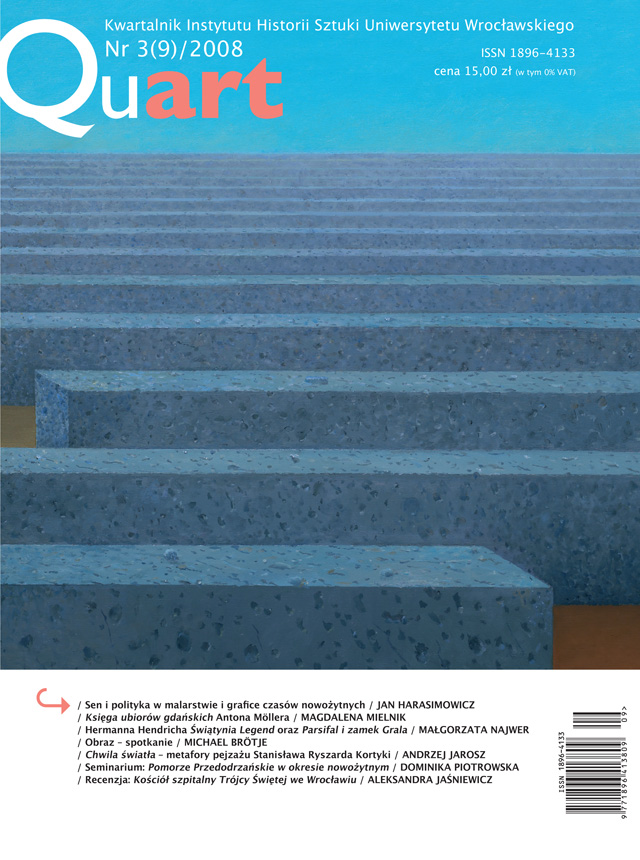Sen i polityka w malarstwie i grafice czasów nowożytnych
Dream and Politics in Modern Painting and Graphics
Author(s): Jan HarasimowiczSubject(s): Fine Arts / Performing Arts, Visual Arts, History of Art
Published by: Wydawnictwo Uniwersytetu Wrocławskiego
Summary/Abstract: Both in Greek and Roman ancient times and Judaism, ‘prophetic’ dreams used to have an important political function. A great role was still ascribed to them in the Christian Middle Ages, what can be seen best in the example of the iconography of two ‘founder’s legends’: one of Santa Maria Maggiore basilica in Rome (Filippo Rusuti’s mosaics on the facade, 1295) and the other one of the Franciscan Order (Giotto’s frescoes in the Upper Church at Assisi, ca. 1300). The Emperor Charles IV of Luxembourg had also – in his youth – ‘political’ dreams, translated into the language of pictorial presentations. At the dawn of an early modern era the dream visions, connected both with common political-religious disorders of the time of the Reformation and the peasant wars (Albrecht Dürer‘s watercolour of Dream of the Great Deluge, 1524) and with some particular political events, e.g. the defeat of the protestant princes of the Reich in the Battle of Mühlberg (Lucas Cranach the Younger’s woodcut engraving of Dream of Filip Melanchton, 1547), became fixed in painting and graphic art. However, we may speak about a remarkable role of ‘dreams’ no sooner as in the period preceding the outbreak of the Thirty Years’ War and of its duration. The propaganda of the both fighting sides reached for a motif of a dream and a dream vision of some important political figures: the protestant Union (Dream of the Saxon Elector Friedrich the Wise, 1617; Dream of the Saxon Elector Johann Georg I, 1631) as well as the catholic League (Dream of King Ferdinand II, 1620). A few works of painting and graphic art of the sixteenth century, entitled as ‘dreams’, may be defined, according to the latest research, as ‘presumed dreams’. It applies both to Domenikos Theotokopoulos’s, called El Greco, painting from Escorial (1576-1579), entitled Dream of Philip II of Spain, which actually appears to be an allegorical Adoration of the Name of Jesus, and the two copper engravings of Dream of Raphael one by Marcantonio Raimondi (1506-1508) and the other by Giorgio Ghisi (1561). The latter, already with a new title Allegory of Human Life, might include some allusions to political situation of France after the King Henry II’s death. As such, it could have come as a political manifesto of the supporting party of the queen-widow, Catherine de Médicis. Still at the beginning of the eighteenth century the motifs of dreams, strictly connected with mediaeval tradition, were used by the Catholic Church fighting against ‘heresy’. Cosmas Damian Asam’s frescoes on the ceiling of the Cistercian church nave in Fürstenfeld near Munich (1723-1731) depicted ‘A white dog expelling the Church enemies’, referring to St. Bernard’s of Clairvaux gravid mother’s dream of the birth of a white dog. Later, in the period of the Enlightenment, a barking dog appearing in someone’s dream, certainly would not be regarded as ‘God’s omen’, but as ‘a nightmare’ from Henry Fuseli’s paintings, or ‘a monster’ from Francisco Goya’s Caprichos, ‘produced’ by a mind plunged in a dream.
Journal: Quart
- Issue Year: 9/2008
- Issue No: 3
- Page Range: 3-19
- Page Count: 17
- Language: Polish

